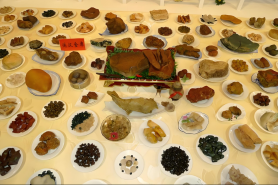
In Chinese history, the famous Manchu Han Imperial Feast (Man Han Quan Xi) was a grand meal. It was said to include 108 special dishes (30 dishes from Zhejiang and Jiangsu cuisines <菜肴>, 12 dishes from Fujian cuisine, 12 dishes from Cantonese cuisine, 12 dishes from Manchu cuisine, 12 dishes from Beijing cuisine, and 30 dishes from Shandong cuisine). This feast was only for emperors.
1.1.Which cuisine is NOT included in the Manchu Han Imperial Feast?
A Fujian cuisine.
B Jiangsu cuisine.
C Beijing cuisine.
D Sichuan cuisine.
解析:选D。D 细节理解题。根据第一段中的“30 dishes from Zhejiang and Jiangsu cuisines, 12 dishes from Fujian cuisine, 12 dishes from Cantonese cuisine, 12 dishes from Manchu cuisine, 12 dishes from Beijing cuisine, and 30 dishes from Shandong cuisine”可知,满汉全席包含30道江浙菜,12道福建菜,12道广东菜,12道满族菜,12道北京菜,30道山东菜。并不包含川菜。故选D。
2.2.What does the underlined word “combined” probably mean?
A Improved.
B Connected.
C Weakened.
D Changed.
解析:选B。B 词义猜测题。根据划线单词前文“At the beginning, Manchu and Han dishes were served apart.”“the Qing emperors wanted to unite these two important groups, so they ordered them to live, work, and eat together”可知,清朝初年,满汉席是分开的,后为团结各民族,将两席的馔肴融合成一席,即满汉席相结合。故选B。
3.3.Who has probably made the Manchu Han Imperial Feast formal?
A Kangxi.
B Yongzheng.
C Shunzhi.
D Guangxu.
解析:选A。A 推理判断题。根据第三段中的“On New Year’s Day of Kangxi’s 23rd year as emperor, both Manchu and Han dishes were served together for the first time at the imperial feast. This tradition then became a rule in the Qing Dynasty.”康熙二十三年的元旦,满族和汉族的菜肴第一次同时出现在御宴上,这一传统后来被称为满汉全席。故选A。
4.4.What’s the feature mentioned about Man Han Quan Xi?
A Full of herbs.
B A variety of flavors.
C Focusing on colors.
D Selected ingredients.
解析:选D。D 细节理解题。根据第四段的“They only chose the best ingredients.”可知,满汉全席选材考究,只要最好的食材。故选D。
5.5.What will the writer probably talk about next?
A Customs of Man Han Quan Xi.
B Development of Man Han Quan Xi.
C Influence of Man Han Quan Xi.
D History of Man Han Quan Xi.
解析:选A。A 推理判断题。根据最后一段内容,尤其是最后一句的“it’s still interesting to learn about”可知,满汉全席不仅菜品丰盛,且整个饮食过程的礼仪隆重,场面宏大。由此可推知,接下来可能会讲到饮食过程中的礼仪。故选A。